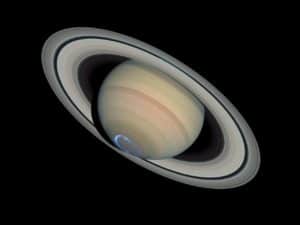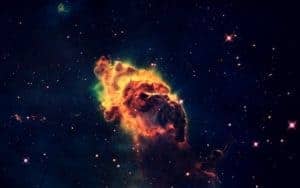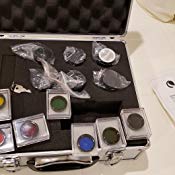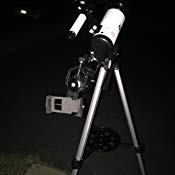We have been accustomed to seeing the fantastic vibrant color of nebulae, galaxies, and planets. Thanks to Hubble and now James Webb telescopes. Who wouldn’t be amazed by the Crayola colors of nebulae, the pink patches of star formations in a galaxy’s spiral arms and the blue hues of starlight reflected in cosmic dust. Even the amazing colors of the planets, themselves are fantastic.
So, Why are Planets Black & White in my Telescope?
In low light human eyes use Rod cells to see. These cells are open to receive a small amount of photons at the expense of seeing detail or color. Photons through a telescope are reduced and your eye uses Rod cells because it requires hundreds of photons to enable a reception of color and detail.
Let’s dig a little deeper and see how to to get some color through a telescope.
Why Does The Cool Stuff Not Look so Cool In My Telescope?
To fully know why this happens, we have to understand how we see objects using our eyes. There are essentially two ways in which we see things with our human eyes, through the Cone cells in our eyes and through the Rod cells.
These two receptors serve different purposes. The Cone cells are the one responsible for sensing colors and are most active during the day. In the night, however, we tend to use the Rod cells because they are better in low light conditions and in sensing motion. But they have a disadvantage of not being able to perceive color.
So, how Did NASA, Or Anybody Get Color Pictures Of The Cosmos?

One other reason is that the very vibrant and colorful images we see of the celestial objects are usually long exposure shots. Light from these celestial objects are generally very faint, so in taking long exposure shots, the camera is able to gather more light and therefore, more color. In viewing from telescopes, we humans don’t have that same ability.
Also, many astronomical pictures are computer enhanced. Often taken in grayscale and offered a color based on the tone of gray it was. Sometimes a more precise spectral analysis of the chemical makeup is undertaken and then assigned a color based on the frequency of the analysis. See awesome NASA images.
Is There a Way Around Black and White Viewing?

Since you can’t rewrite your DNA to see full color in low light, we have to look at how to allow more light into our view. One way is to get a bigger telescope, but it may only help a little bit, and if you just bought your telescope to find out NASA has been cheating on some of their images, so we will keep it to solutions that can be added to your existing scope.
The first thing to do that can help is, get a good quality Barlow lens this increases focal length on the same amount of light being received. This technically doesn’t allow more light, but allows you to see more detail on the same amount of light.
Next, we will go into more affordable solutions. To learn more about a Barlow Lens click here.
Before We Go That Route, We Need To Talk About Filters.
One very cheap and easy way to do this is through the use of color filters. The light that forms the images that we see from a telescope is composed of a spectrum of different wavelength and colors.
All of these different wavelengths can interfere with each other, so using a color filter to isolate only a narrow region of the whole spectrum can significantly increase our perception not only with the colors but also with detail.
For each celestial body, there are actually specific color filters that you can use to enhance detail, see more color and uncover hidden contrast and surface markings. Below are some excellent beginner filters to consider.
What is a Color Filter?

A color filter is merely a transparent material that absorbs some colors while allowing all others to pass through. By doing this, we can eliminate unwanted colors from our view and helps us focus on those that add more details.
There are a Lot of Available Color Filters. Which Ones are the Best to Start Out With?
For a small telescope with an aperture between 70 and 110mm, the filters #8 light yellow, #21 orange, #80A blue, and Baader Neodymium would be the best combination for planetary viewing. There are tons of other types of filters that are available for a variety of different purposes. For a complete article on filters click here.
#8 Light Yellow Filter
All objects seen through this filter will appear to have a yellowish hue by cutting the violet and deep blue light of the spectrum. It is beneficial in enhancing details of the lunar craters, mountains, and rilles (meaning the appearance of grooves) on the moon.
It can also be used to improve details on some of the planets: It enhances the dark albedo ( the light and dark contrast) features on Mars and makes them easier to see, it also improves Saturn’s and Jupiter’s cloud belts. It can also be used to enhance the contrast of the dust tail of comets.
#21 Orange Filter
All objects seen through this filter will appear to have a distinct orange hue by cutting out violet, blue and green part of the spectrum. For the moon, this filter can be used to increase the contrast of small details along the terminator.
Same with the #8 Light Yellow, it enhances the dark albedo features on Mars. For Jupiter, it can improve the bluish features of Jupiter’s atmosphere. This filter can also be used for twilight observations of Mercury, Venus or the moon by darkening out the twilight sky.
#80A Blue Filter
All objects seen through this filter will appear to have a distinct blue hue by increasingly dimming out the colors green to red. This filter can be used to significantly improve the contrast to see the maria and crater rays on the moon better. It is also used to see shadings in Venus’ upper atmosphere, Mars’ polar ice caps and even Jupiter’s Great Red Spot and colored cloud belts.
Baader Neodymium filter
This color filter is different than the rest in the sense that it doesn’t block a whole range of colors but several sections of it. The most prominent of these is for yellow light, as it blocks most of it out. It has the effect of enhancing colors and contrast while at the same time leaving natural colors almost intact.
This color filter also has the advantage of having a hardly noticeable impact on the colors of the objects viewed through it.
For the moon, Mars and Jupiter, it has the same effect in increased contrast as the #21 Orange and #80A Blue, but without the addition of an orange hue. It also gives more enhanced contrast to Saturn’s cloud belts than #8 Light Yellow.
Check out my recommended filter kit by clicking here. You don’t need a kit per say, you can get individual color filters that benefit you and what you are viewing at!
Is there Any Other Way?
One way to view vibrant colors through a telescope is by using a camera. The camera can be set on a timed exposure allowing light in and thereby improving the color received.
Of course, the best cameras for the job are DSLR’s and MIrrorless bad boy cameras. But, we said we would talk about affordable solutions. Click here to learn more about astrophotography.

As we had mentioned a telescope with a wider field of view does help allow more color through the eyepiece, but filters can enhance specific colors and make others pop, and along with a good quality Barlow lens, you may actually be happy with your view.
But, it is possible to buy a cell phone adapter for your telescope, and use an app that creates time exposed pictures. Thus allowing for a high def image that is time-exposed to allow more light to be captured.
The one downfall to doing simple time-exposed cell phone astrophotography is; you will need a motorized Right Ascension to keep track of the object over the timed shot for explicit detail. Learn more about the cell phone and telescope mount adapter I use from Amazon, by clicking here.
Need More?
If you have gone into astronomy as a hobby for spectacular views, you may have been disappointed because when viewing these objects from a telescope, the vibrant colors are not visible most of the time. But In the end, astronomy as a hobby is never about beauty alone. The ability to see the cosmos through your own telescope is the joy of discovery.
You may also like these articles
How Dark is the Sky Above Your Telescope


